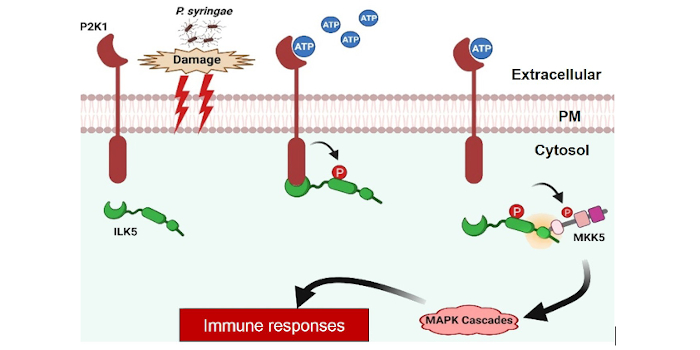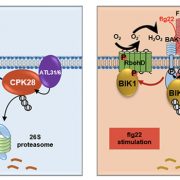A Raf-like MAP kinase kinase kinase regulates purinergic receptor-mediated innate immunity in Arabidopsis
Kim et al. explore how extracellular ATP recognition triggers the innate immune response.
By Daewon Kim1, Dongqin Chen1,3, Nagib Ahsan2,4,5, Gabriel Lemes Jorge2, Jay J. Thelen2 and Gary Stacey1,2,*
1Division of Plant Science and Technology, C.S. Bond Life Science Center, University of Missouri, Columbia, MO 65211 USA
2Division of Biochemistry, C.S. Bond Life Science Center, University of Missouri, Columbia, MO 65211 USA
3Present Address: State Key Laboratory of Agrobiotechnology, College of Plant Protection, China Agricultural University, Beijing, 100193 China
4Present Address: Department of Chemistry and Biochemistry, The University of Oklahoma, Norman, OK 73019, USA
5Present Address: Mass Spectrometry, Proteomics and Metabolomics Core Facility, Stephenson Life Sciences Research Center, University of Oklahoma, Norman, OK, USA
Background: Extracellular ATP acts as a signaling molecule that is perceived by eukaryotic P2-type purinergic receptors, which are located in the plasma membrane. Purinergic signaling has been extensively studied in animals, including humans, but is less studied in plants. Pathogen invasion and subsequent wound stress releases extracellular ATP (eATP), a danger-associated molecular pattern (DAMP) signal, inducing purinergic signaling cascades, which result in phosphorylation of mitogen-activated protein kinases (MAPKs). Previous studies revealed that the P2K1 purinergic receptor increases MPK3/6 phosphorylation in response to eATP mediated purinergic signaling cascades in Arabidopsis.
Question: How does eATP recognition result in the activation of the MAP kinase cascade, which is essential for induction of the innate immune response in Arabidopsis plants?
Findings: The Raf-like MAPKKK INTEGRIN-LINKED KINASE 5 (ILK5) was shown to be a downstream substrate of P2K1 kinase activity. Initiation of an eATP-dependent signaling pathway by phosphorylation of ILK5 results in phosphorylation and activation of MKK5 leading to phosphorylation of MPK3/6 and downstream events crucial to the plant innate immune response.

Next steps: The discovery that release of eATP by pathogen invasion regulates MPK3/6 activation through phosphorylation of ILK5 provides information on DAMP signaling and pathogen resistance in plants. Future studies should aim to identify the plant mechanisms targeted by ILK5-mediated purinergic signaling cascades and use this knowledge to protect crops from the deleterious effects of a wide range of pathogens.
Daewon Kim, Dongqin Chen, Nagib Ahsan, Gabriel Lemes Jorge, Jay J. Thelen and Gary Stacey. (2023). The Raf-like MAPKKK INTEGRIN-LINKED KINASE 5 regulates purinergic receptor-mediated innate immunity in Arabidopsis https://doi.org/10.1093/plcell/koad029




